|
| Author |
Message |
RazrRebel
Member
|
# Posted: 9 Apr 2015 20:13
Reply
Just got one quick question. If you could get a small propane / electric fridge, could you run it on solar / battery during the day and switch to propane at night. Automatically?
|
|
darz5150
Member
|
# Posted: 9 Apr 2015 20:34
Reply
I am not an expert but some of the ones I've seen either run on a/c or 12 volt+ propane. I am currently salvaging one out of a fifth wheel camper that has a switch for 120 volts ac or propane/12 volts dc.
Maybe you could look at Sun Dazer, Danby, or Dometic brands to see if they have an auto model.
|
|
MtnDon
Member
|
# Posted: 9 Apr 2015 21:07 - Edited by: MtnDon
Reply
The electric portion of propane/electric refrigerators use an electric resistance heater to provide the heat in place of the propane burner flame. Usually resistance heating is a poor idea when off grid. IIRC a 4 cu ft size will use something like 14 - 15 amps on 12 VDC. Smaller will be less, larger will be more. That's a big drawback in my book. Yes the PV system could be sized to run that while the sun shines and for a few hours before and after peak sun times.
I know that some of the newer RV models will auto change between propane and 120 VAC, but they will not change between propane and 12 VDC because of the high current on 12 VDC; an RV battery would be used up fairly quickly when parked. So if you wanted to use DC during sunny periods and change to propane when not sunny you would have to change it manually. That kind of limits it's use if you are not there. You'd have to check further yourself to see if there are any that are able to use DC. Of course you could run it off an inverter but IMO that is not too practical as that involves using even more energy.
The newer model propane/electric RV type fridges also use 12 VDC power all the time to operate the electronic control system. IIRC 1 to 2 amps even when running the refrigeration on propane. Older models had no electronics. Similarly the Servel propane fridges use zero electric power when operating on propane. They can run on 120 VAC; they have an AC electric heater for emergency use if propane runs out. They do not auto change though.
IMO, if the fridge is being used in a part time use cabin it makes good sense to use propane only for the fridge. If the use is in a full time use cabin/home then it makes sense to have a larger PV array, more battery storage and run a regular residential refrigerator on 120 VAC; a high efficiency Energy Star fridge and a good pure sine wave inverter, not bargain basement fridge and not a modified sine wave inverter.
If 4 cu ft is a good size you can also look at something like the Truckfridge 130. $600; more than a 120 VAC but cheaper than a propane. It uses a 12/24 VDC compressor. Very efficient. We use one in our cargo trailer conversion (to camper trailer). A small PV array can keep that going forever.
|
|
RazrRebel
Member
|
# Posted: 10 Apr 2015 05:22
Reply
Thanks guys. Just trying to sort a few things out before we start building. The Truckfridge seems like a good alternative. I'll have a look at that.
|
|
Jim in NB
Member
|
# Posted: 10 Apr 2015 06:04
Reply
I use a Dometic propane fridge - uses less than a pound of propane a day - and no hassles and no big power demand. One less I learned the hard way was to make sure you plan on putting your fridge on an outside wall for venting - with my fridge it can only exhaust around 5'!
|
|
old greybeard
Member
|
# Posted: 10 Apr 2015 07:42 - Edited by: old greybeard
Reply
We love our dometic, best thing we ever bought for the cabin. Only uses a small amount of propane. Works when its over 90 degrees, keeps ice cream hard as a rock.. We had a rv propane fridge initially, but it could not keep up in very hot weather.
I wouldn't even consider using the electric portion of ours.
Don't understand the need to vent, we just have the stack behind the fridge with no external vent, nor is one called for in the instructions. No smell or co2 alarm trip either.
|
|
MtnDon
Member
|
# Posted: 10 Apr 2015 09:54
Reply
Re the venting question: it is more orless a safety measure. Propane fridges are notorious for CO production if you do not perform proper maintenance. The flame can produce a little soot that can promote CO production. If the fridge burner is not jetted to the altitude that can cause CO production. A propane fridge that is used sporadically is at risk for CO production as in a part time cabin where the fridge is turned off for weeks at a time. The risk then is from spiders building webs in the burner. For some reason they like to do that. The web can cut down air flow; reduces air to the burner = CO production.
So the key is to pull the fridge out from the wall and clean the burner and chimney tube a couple of times a year. That should be a part of a spring cabin opening for those who do not use over the winter. Or install a vent system. Note that RV's all have built in venting to the exterior; that should tell us something. And have an operational CO detector / alarm.
|
|
groingo
Member
|
# Posted: 10 Apr 2015 10:05 - Edited by: groingo
Reply
The best thing you can do with any fridge is insulate the pogees out of it and better yet add removable insulated dividers inside the fridge for when you just have a few things inside, can reduce run times by a lot when not cooling empty space and try hard to get one with a soft start feature, greatly reduces start up power spikes.
|
|
|
MtnDon
Member
|
# Posted: 10 Apr 2015 10:44
Reply
Quoting: groingo soft start feature
= truckfridge
There is a side benefit of building a chase behind the propane fridge, replicating the venting as used in an RV fridge system. Not only is the burner exhaust and heat vented outside, the heat removed from the interior of the fridge box is vented outside. Helps to keep cool inside in summer. In winter the system could be changed to vent inside and retain all that heat. We did that and have a CO detector.
|
|
groingo
Member
|
# Posted: 10 Apr 2015 13:58
Reply
Don, there seem to be a lot of makers of soft starts that can be used with conventional fridges, might be worth a look.
|
|
beachman
Member
|
# Posted: 10 Apr 2015 15:21
Reply
I too have a Dometic propane fridge and agree with MtnDon's comments on cleaning the burner periodically. I have a vent kit but have not hooked it up yet and keep an eye on the burner - so far, so good. No problems with air quality or CO - have a detector now and all is good. I have plans to eventually vent to the outside for safety reasons and it will be slightly more efficient with cooler outside air. Jim in NB - saw your set up and I would consider a vent up and out and put the fridge where you originally wanted it - just a thought.
|
|
MtnDon
Member
|
# Posted: 10 Apr 2015 16:22
Reply
I have used the Servel/Dometic fresh air kit. Or rather tried to use it. We had flame out issues that I tracked down to be from the gusty winds on the ridge top hitting the wall the vent went through. After trying to make it work 100%, I gave up because it was not dependable enough to leave for a day or more and be sure the fridge would still be operating. That's when I built the chase behind it and installed other vents in the exterior wall. That has worked 100%. Eventually the guy where we bought the kit admitted that sometimes there were problems. Since you have the kit you should probably try it. I think it is a great idea. But be aware that some folks have had problems.
I can dig up pictures if anyone wants to see what I did.
|
|
thetick
Member
|
# Posted: 10 Apr 2015 17:38
Reply
Just picked up a Dometic 1350 a month ago. It' propane/electric with constant 12vdc required. It will either run on propane or when set to AUTO it will default to AC but when we go to bed and turn off the inverter it will switch to using propane. In the morning when it senses AC (we turn the inverter back on) it goes back to ac mode.
So far we love it. Uses little propane, and a 20# bottle lasted 22 days (but we only run t 8 hours a day, or when cloudy/low solar days).
|
|
creeky
Member
|
# Posted: 10 Apr 2015 19:42
Reply
as most of you know I'm big on electric only fridges.
my fridge is 10 cu ft and cost 400 delivered. It has a big freezer. and a giant fridge. well. compared to my 9 cu ft propane/electric fridge.
And it uses 20-40 watts/hr (500/day) depending on room temperature.
Let's do the numbers. I sold my propane fridge and bought the electric. net: 600 bucks for me. I have now used the electric fridge for over 2 years without a day off. compare to $1.25 in propane / day. Savings to date are coming up to 900 dollars and I'm still saving.
1500 bucks buys a lot of panel/battery/controller solar stuff.
Just a thought. A small solar system will run some of those "dorm" fridges. The Danby is a real miser on power. And it's what. 2-300? In particular. If you're only running your fridge during the long sunny days of summer... peak solar.
The real benefit of propane fridges is that they can handle bumps and shaking. if it's not in a vehicle ... why pay for that ability. and a solar system with batteries will have other uses.
so $$ savings plus. no co2. none. or co. or emissions. just cold frosty stuff. and more of it. now that's gotta get wife approval.
|
|
bobrok
Member
|
# Posted: 10 Apr 2015 19:43
Reply
Quoting: MtnDon I can dig up pictures if anyone wants to see what I did.
Don, if you don't mind, I'd like to see this chase you built. I'm not sure if I'm following this thread correctly, but are you saying if you have a non-vented propane fridge, as do I, you can build a vent system via a chase?
Tnx.
|
|
MtnDon
Member
|
# Posted: 10 Apr 2015 20:18 - Edited by: MtnDon
Reply
Okay, here goes. 9 pictures. Pretty much self explanatory... but here are some comments...
picture 2... The lower vent is not at floor level. I kept it higher to help head off any issues with wind gusts that might affect the burner. It has worked well. Never had a flame out even once.
picture 4... The condenser fits quite tight to the wall. The idea is to force the rising air behind the fridge to pass through the fins to be most effective at removing heat. I added a section of foam rubber that is stuck to the wall later to make an absolute tight seal between the condenser and wall.
more images in next post.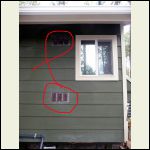
vents on the exterior wall
| 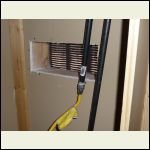
lower vent, inside
| 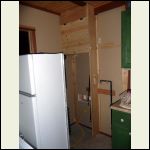
chase
| 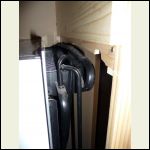
condenser clearance
|
|
|
thetick
Member
|
# Posted: 10 Apr 2015 20:19
Reply
Quoting: creeky it uses 20-40 watts/hr (500/day)
Very nice creeky. Can you throw out a model on it?
I went propane as my water heater, and stove are propane as well so, it made sense to me. I figure when the tank is installed (500 gallon) it will last almost 3 years with current habits.
Also, when I'm out of town I can turn off the inverter and the main at the box and just leave.
|
|
MtnDon
Member
|
# Posted: 10 Apr 2015 20:22
Reply
picture 5... the left side, against the wall is blocked with a length of pipe insulation when we want to vent to the exterior. There is also a short section that fits between the case bottom and the floor.
pictures 6 & 7... a hatch in the chase side permits access to the gas shutoff valve.
more in next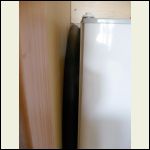
pipe insulation gasket
| 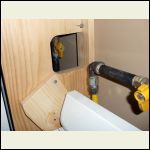
gas valve access port
| 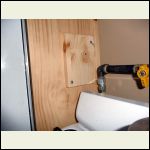
gas valve access closed
|  |
|
|
MtnDon
Member
|
# Posted: 10 Apr 2015 20:25 - Edited by: MtnDon
Reply
picture 9... In cool seasons when we can use the heat inside we can open the upper inside vent hatch. We then remove the two pipe insulation gaskets to permit the circulation of inside air. The exterior vents are removed and a section of Hardi-plank painted to match the wall is placed over each opening. That keeps the cold outside air outside.
I clean the burner tubes with a long wire handled brush and make sure the CO selector batteries are fresh.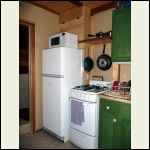
fridge in place
| 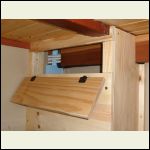
top inside vent open to interior
|  |  |
|
|
bobrok
Member
|
# Posted: 10 Apr 2015 21:29 - Edited by: bobrok
Reply
Thank you, Mtn Don. That's quite an elaborate setup. So my understanding of your explanation is that you choose by season whether to vent inside or outside?
I know from previous conversations that you are not a big 'vent free' proponent. Can I take it from your description, then, that outdoor venting of a fridge is more for convenience sake in warm weather and that you aren't as much concerned with non-venting of the fridge during cooler seasons, as you are with propane heaters?
BTW, I've also had the creepy crawlers and am utmost aware of frequent and proper maintenance of seasonal propane fridges.
After you've mastered the special techniques of restarting and chilling down an occasionally used propane fridge it's a relative snap to do it as compared to leaving it burning unattended and suffering the possible consequences.
Been there, done that.
edit: apologies to the OP for drifting way off topic. I find I'm prone to do this. 
|
|
MtnDon
Member
|
# Posted: 10 Apr 2015 21:39
Reply
A propane fridge uses so little fuel per hour compared to a space heater I decided there was not much to worry about. With that backed up by two CO detectors I don't give it a second thought. The other thing that an unvented space heater does is the large amount of water vapor released inside. Again the fridge volume is so low any water vapor is unmeasurable.
Yes, in the case of the fridge one of the big advantages was to route all the heat outside just like in an RV, when the heat is not desired to be added to the interior. Switching to inside or outside venting is a difference that can be felt.
|
|
creeky
Member
|
# Posted: 11 Apr 2015 09:21
Reply
ya tick. it's a magic chef. i think Danby makes one about that size too. the MC gets mediocre reviews online. but mine has worked fine for two years and counting.
i only bring up the electric fridge because it's cheaper for full timers. for you'ze all that come and go. propane is more expensive. requires things like the chase that mtn don built. piping etc.
but it's probably more flexible? i don't know. if i was coming and going each fridge needs to be started and stopped.
all i know is I was hauling and filling 2 30lb tanks every 6 weeks. And now I don't.
btw: danby DFF100C2WDD. uses less than 300 kw/yr. And with the new test rules they operate these things at 25C/77F and open and close doors frequently. my MC reads around 500 watts per day in the winter with my use (logged with an EM100).
|
|
Steve_S
Member
|
# Posted: 11 Apr 2015 10:03
Reply
I have a Danby 10cu fridge/freezer and love it for it's low power use @ 312 kWh per year. I got this at Costco on sale for $468.00 CAD. Danby DFF100A1SLDB
Their latest models which are similar use even less juice @ 297 kWh per year such as this model Danby dff100c2bsldd.
My only "peeve" is that it is on the low side, so bending over to get things out of it. Contemplating building a little platform to put it on in the cottage, maybe with a drawer under it.
One really nice thing (although putting it on a "drawer" would cancel it) is that it's real easy to pull out and clean behind/under it, so you can keep the dust bunnies out... Dirty coils & clogged cooling increases energy use significantly.
|
|
|

